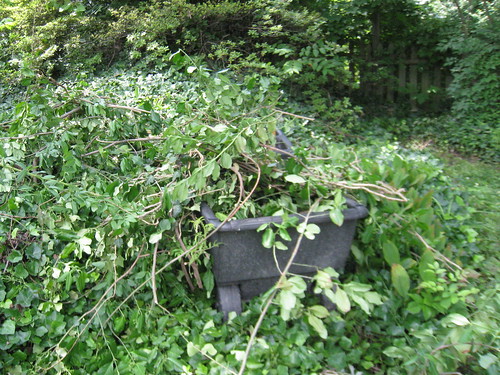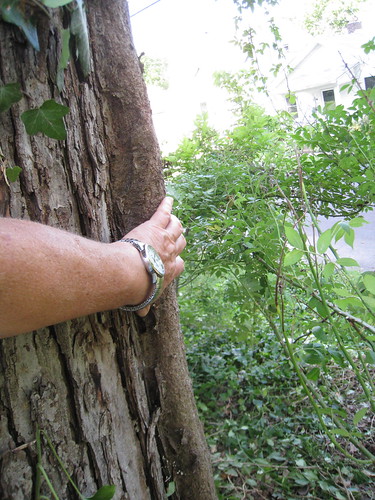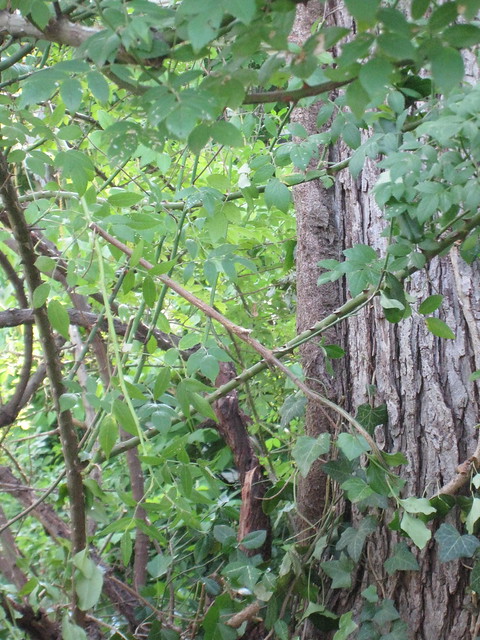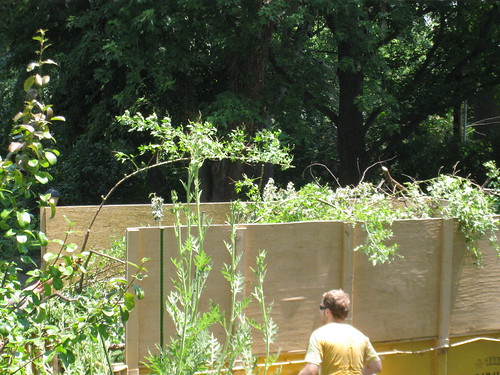It started with a great idea and a colossal winter creeper vine (Euonymus fortunei).
Some time in the late 80s I started growing antique roses. Well, I saw this fabulous photo of a climbing rose called 'Seagull' romping through the tree tops in an English garden. I ordered it from specialty nursery in California. I planted it on the downhill (eastern) side of my huge silver maple in the front yard. Shortly afterwards, I received a note from the nursery saying that they did not send me 'Seagull,' but 'Rambling Rector.' This isn't too unusual with antique rose varieties. I don't know even today what difference there is between the two. Both have thousands upon thousands of small, white, fragrant, semi-double blooms that appear once a year, from mid-May to early June. True to its rambling nature, 'Rambling Rector' threw its long canes around the maple's trunk climbing ever higher. There were setbacks of frost or falling maple limbs but the plant always recovered, leaping into my neighbors sweet gums, and heading towards my front door.
You're supposed to prune ramblers by removing the oldest canes after the bloom. Let's just say that whoever came up with the idea of putting yard waste into paper bags never pruned a climbing rose. The canes are often 10 feet long—up to 20—and then there are those bloodthirsty thorns! The plant of course uses thorns to latch onto limbs and climb. They probably discourage cows and woolly mammoths too.
A victim of my own gardening success, I've worn out the pruners, jeans, gloves, and lacerated my scalp trying to control this plant. Most years, my enthusiasm for the charming blossoms
was overwhelmed by cowardice, and the plant went unpruned.
Enter, St. Louis Audubon. SLAS is piloting a program called "Bringing Conservation Home" to encourage homeowners to include in their landscape plants that are native to the area, and help sustain native wildlife and I was lucky to be invited to be a part of it. Dave Tylka, author of Native Landscaping for Wildlife and People, and Mitch Leachman, Executive Director of St. Louis Audubon Society head up the team, but like me, most of us are interested amateurs. We visit the homes of gardeners who invite us, provide an inventory of plants in the landscape, and offer suggestions for landscaping that will improve their habitat.
I already have a good portion of my yard devoted to native plants, but there's more to it than that; namely, fighting those invasive, exotic plants. I hacked and sprayed my bush honeysuckle some time ago, but there's another villain in the picture: winter creeper (Euonymus fortunei). I knew winter creeper was non-native, but I didn't realize the harm it can do as it smothers the landscape. All the qualities that make it a useful ground cover also make it destructive to the environment: vigor, tolerance of a wide variety of conditions, and the ability to form an evergreen mat of foliage to shade out competitors.
I also wasn't aware that, like English ivy (Hedera helix), winter creeper matures, blooms, and forms seeds only when it able to climb high enough to reach good light. Take a second look at my first photo. See the green vine? And the sneaky bush honeysuckle at lower center, buried within the monster rose?
So I got motivated. I tried just removing the winter creeper.


Pole pruner, loppers, leather gloves are all worse for the wear. I almost lost my shorts to the thorns, and in the front yard, that's a problem. I looked like I'd just boxed six rounds with a buzz saw and lost.
At last, I threw in the towel. I hired someone to remove the vines, rose and all. Now I've got a huge new space to fill with native plants that hopefully will be attractive all year long.




I imagine that some North American plants are invasive in Europe too. It's certainly an on-going project, but the results will be worth it!
ReplyDelete